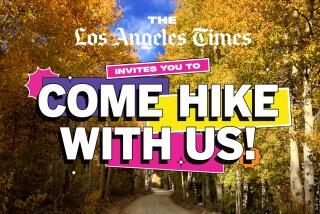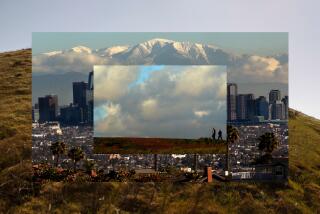Accessible Wilderness Awaits in Pasadena’s Arroyo Seco
Arroyo Seco undoubtedly is the best-known canyon in Southern California. It’s the site of the Rose Bowl and has the dubious distinction of hosting California’s first freeway, the Pasadena. The arroyo includes 10 miles of urban canyon dominated by the freeway and 10 miles of wild and rugged watershed spilling from the shoulder of Mt. Wilson.
In Pasadena, between the end of the freeway and the beginning of the Angeles National Forest, the arroyo takes on a third dimension, what land-use planners refer to as “the urban/rural interface.” Here the arroyo has been domesticated, but not destroyed. And here the walker will find a little leg-stretcher of a hike that recalls the Pasadena of a century ago. Rose Bowl-goers will find a fun way to reach the stadium.
For Nature Lovers
Since before the turn of the century, the arroyo has been a pleasuring ground for nature-loving Pasadenans. Old photos show a verdant canyon with trails meandering along wooded banks.
During the last decade of the last century and the first decade of this one, the banks of the Arroyo Seco hosted a way of life historians now call Arroyo Culture. Artists, writers, wealthy eccentrics and assorted nonconformists settled in this suburb, so uniquely positioned between the wilderness and fast-growing Los Angeles. Many decades before today’s “Southwest Look” became so trendy, Arroyo residents gloried in Indian and Mexican cultures. They filled their homes with Indian blankets and pottery, stained glass and colored tile.
Pasadena purchased the arroyo from the Pasadena Land & Water Co. in 1912. Over the years, the arroyo hasn’t always been so seco . In fact, during some winters quite a torrent rushed down the arroyo. Devil’s Gate Dam and Reservoir were built to capture the arroyo’s runoff, and a concrete channel was built to direct its flow. Today, as a result of all these flood-control measures, the trail along the Arroyo Seco is no wilderness adventure, but it does afford a pleasant walk into Pasadena’s past.
Directions to the trailhead: From the Pasadena Freeway in South Pasadena, exit on Marmion Way/Avenue 64. Bear left and look for York Boulevard. Turn right on York and then almost immediately turn left on San Pascual Avenue. Drive three-quarters of a mile to Arroyo Seco Park, where there’s plenty of parking. Best bet for hikers is the small lot near the softball field. Arroyo Seco Trail departs from San Pascual Stables, just up the avenue on the left side of the road. Don’t park in the stables’ lot.
The hike: The trail, signed “Horseback Riding Trail,” begins at the north end of the stable grounds. A 50-yard walk brings you to a small bridge over the arroyo flood-control channel. Here you may choose which side of the arroyo you’d like to walk; equestrian trails parallel both sides of the channel for about a mile.
Arroyo Seco Trail passes native oak, alder and sycamore, as well as arboreal imports from faraway lands--eucalyptus, palm and pepper trees. Pasadenans have been cultivating gardens at the arroyo’s edge for about a century, and some mighty strange flora have escaped from these gardens and sprouted on the canyon walls and bottom. Bougainvillea, bird of paradise and dozens of other exotic plants now decorate the arroyo.
High above you, atop the arroyo walls, are some fine old homes--Bavarian, Victorian, Tudor and Anyone’s Guess in style--and all but hidden by the profligate vegetation.
As you approach an archery range, note the huge castle-like structure high on the arroyo’s east bank. This is the Vista del Arroyo Hotel, finished in 1936 and now a federal office building.
Under the Bridges
The trail takes you beneath a trio of bridges arching over the Arroyo Seco. Unlike the arroyo flood-control channel, the bridges are an aesthetic triumph. Particularly pleasing to the eye is the Colorado Boulevard Bridge, known in the 1930s as Suicide Bridge. Many wealthy Pasadenans were hard hit by the 1929 stock market crash and leaped off the bridge. Seventy-nine people were reported to have jumped. In 1937 the city built a high fence and stationed a guard on the bridge.
Somewhat ironically, the most natural part of the arroyo that you’ll encounter along this trail is found beneath the Colorado Boulevard and Ventura Freeway bridges. Eastside and westside arroyo trails join together near a spillway and finally depart from the straight-line course of the flood-control channel. The path follows a little creek, which hints at what the arroyo might have looked like before its ecology was forever altered by engineers.
Arroyo Seco Trail emerges from the greenery near the corner of Arroyo Boulevard and Seco Street. The Rose Bowl is dead ahead. Walk along Arroyo Boulevard a short distance to Brookside Park, where you can picnic in the shadow of the Rose Bowl.
A signed “Horseback Riding Trail” continues north another mile, first passing through the Rose Bowl parking lot, then continuing alongside West Drive past Brookside Golf Course. Skip this boring path, eat your lunch at Brookside Park and return the same way.
Arroyo Seco Park to Rose Bowl: 3 miles round trip
More to Read
Sign up for The Wild
We’ll help you find the best places to hike, bike and run, as well as the perfect silent spots for meditation and yoga.
You may occasionally receive promotional content from the Los Angeles Times.






